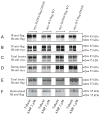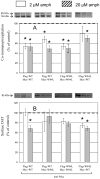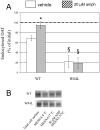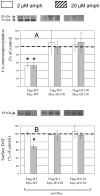Interrelation of dopamine transporter oligomerization and surface presence as studied with mutant transporter proteins and amphetamine
- PMID: 20492355
- PMCID: PMC2910181
- DOI: 10.1111/j.1471-4159.2010.06818.x
Interrelation of dopamine transporter oligomerization and surface presence as studied with mutant transporter proteins and amphetamine
Abstract
Our previous work suggested a role for oligomerization in regulating dopamine transporter (DAT) internalization, with d-amphetamine dissociating DAT oligomers and monomers being endocytosed. This model was put to detailed testing in the present work with the use of DAT constructs differentially tagged with Myc or Flag, reversal of tags in co-immunoprecipitation and cross-linking assays, and application of antibodies against different tags in biotinylation experiments. Upon pairing wild-type (WT) DAT with W84L mutant, effects of d-amphetamine on oligomerization (decrease) but not surface DAT are observed. Internalization of W84L monomers appears to be slow as inferred from the inability of d-amphetamine to reduce surface Myc upon co-expressing Flag-WT with Myc-W84L but not Myc-WT with Flag-W84L, and from the sluggish Myc-W84L endocytosis rate (both with or without d-amphetamine). Results obtained for D313N, D345N, or D436N mutants can all be accommodated by a model in which D-amphetamine is unable to dissociate mutant protomers from oligomers (tetramers or higher-order assemblies) that contain them; this interpretation is confirmed in experiments with both tag reversal in co-expression and antibody reversal in western blotting. Upon co-transfecting Myc- and Flag-tagged constructs, resulting tetramers can be calculated to be composed of different species (MycMycMycMyc, MycMycMycFlag, MycMycFlagFlag, MycFlagFlagFlag, and FlagFlagFlagFlag), but it is shown that outcomes predicted by models based on MycMycFlagFlag oligomers are not changed in a major way by the occurrence of the additional species.
Figures











Similar articles
-
Substrates dissociate dopamine transporter oligomers.J Neurochem. 2008 May;105(3):910-20. doi: 10.1111/j.1471-4159.2007.05195.x. Epub 2007 Dec 18. J Neurochem. 2008. PMID: 18088380 Free PMC article.
-
Dopamine transporter oligomerization: impact of combining protomers with differential cocaine analog binding affinities.J Neurochem. 2015 Apr;133(2):167-73. doi: 10.1111/jnc.13025. Epub 2015 Jan 26. J Neurochem. 2015. PMID: 25580950 Free PMC article.
-
Differential targeting of the dopamine transporter to recycling or degradative pathways during amphetamine- or PKC-regulated endocytosis in dopamine neurons.FASEB J. 2013 Aug;27(8):2995-3007. doi: 10.1096/fj.12-218727. Epub 2013 Apr 23. FASEB J. 2013. PMID: 23612789 Free PMC article.
-
Phosphorylation of the Amino Terminus of the Dopamine Transporter: Regulatory Mechanisms and Implications for Amphetamine Action.Adv Pharmacol. 2018;82:205-234. doi: 10.1016/bs.apha.2017.09.002. Epub 2017 Oct 25. Adv Pharmacol. 2018. PMID: 29413521 Free PMC article. Review.
-
The dopamine transporter: a vigilant border control for psychostimulant action.Handb Exp Pharmacol. 2006;(175):215-32. doi: 10.1007/3-540-29784-7_11. Handb Exp Pharmacol. 2006. PMID: 16722238 Review.
Cited by
-
Effect of Dimerization on the Dynamics of Neurotransmitter:Sodium Symporters.J Phys Chem B. 2017 Apr 20;121(15):3657-3666. doi: 10.1021/acs.jpcb.6b09876. Epub 2017 Feb 7. J Phys Chem B. 2017. PMID: 28118712 Free PMC article.
-
Direct coupling of oligomerization and oligomerization-driven endocytosis of the dopamine transporter to its conformational mechanics and activity.J Biol Chem. 2021 Jan-Jun;296:100430. doi: 10.1016/j.jbc.2021.100430. Epub 2021 Feb 18. J Biol Chem. 2021. PMID: 33610553 Free PMC article.
-
Amphetamines, new psychoactive drugs and the monoamine transporter cycle.Trends Pharmacol Sci. 2015 Jan;36(1):41-50. doi: 10.1016/j.tips.2014.11.006. Epub 2014 Dec 23. Trends Pharmacol Sci. 2015. PMID: 25542076 Free PMC article. Review.
-
Optogenetically-induced multimerization of the dopamine transporter increases uptake and trafficking to the plasma membrane.J Biol Chem. 2021 Jan-Jun;296:100787. doi: 10.1016/j.jbc.2021.100787. Epub 2021 May 18. J Biol Chem. 2021. PMID: 34015332 Free PMC article.
-
Presynaptic dopamine modulation by stimulant self-administration.Front Biosci (Schol Ed). 2013 Jan 1;5(1):261-76. doi: 10.2741/s371. Front Biosci (Schol Ed). 2013. PMID: 23277050 Free PMC article. Review.
References
-
- Balasubramanian S, Teissere JA, Raju DV, Hall RA. Hetero-oligomerization between GABAA and GABAB receptors regulates GABAB receptor trafficking. J Biol Chem. 2004;279:18840–18850. - PubMed
-
- Berger SP, Farrell K, Conant D, Kempner ES, Paul SM. Radiation inactivation studies of the dopamine reuptake transporter protein. Mol Pharmacol. 1994;46:726–731. - PubMed
-
- Chen N, Ferrer JV, Javitch JA, Justice JB., Jr Transport-dependent accessibility of a cytoplasmic loop cysteine in the human dopamine transporter. J Biol Chem. 2000;275:1608–1614. - PubMed
-
- Chen N, Reith ME. Substrates and inhibitors display different sensitivity to expression level of the dopamine transporter in heterologously expressing cells. J Neurochem. 2007;101:377–388. - PubMed
Publication types
MeSH terms
Substances
Grants and funding
LinkOut - more resources
Full Text Sources

